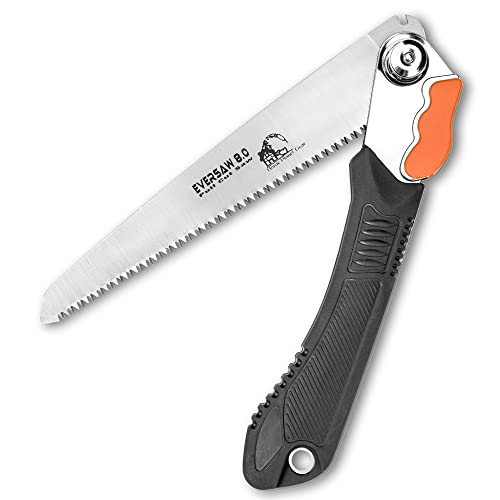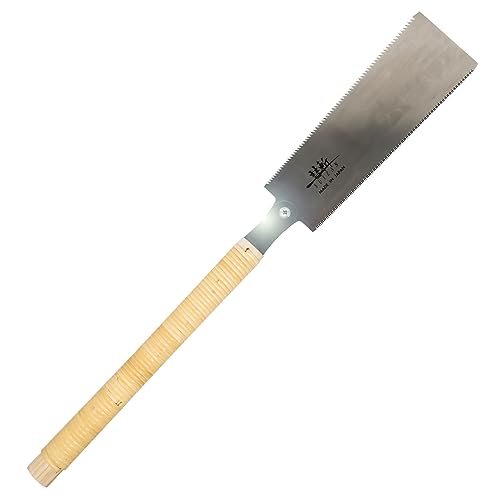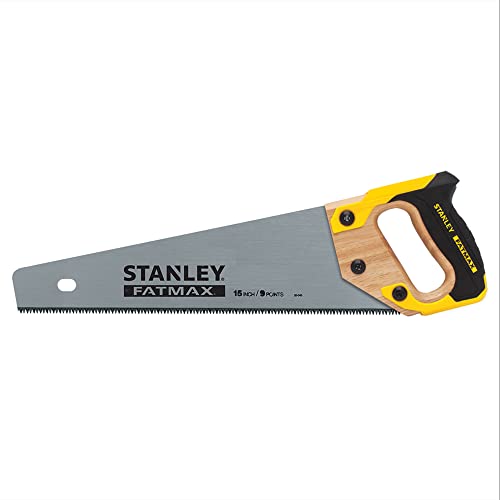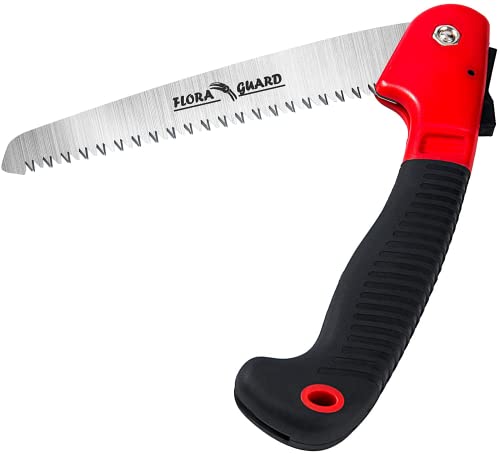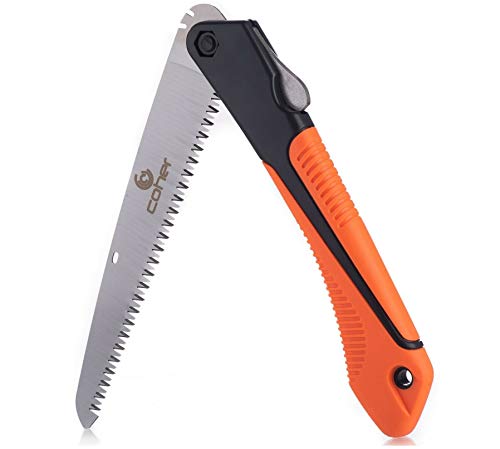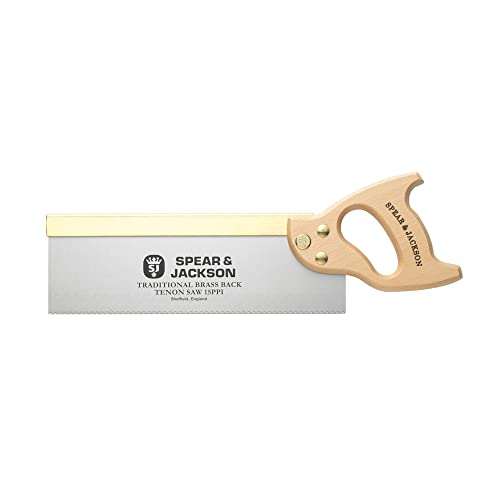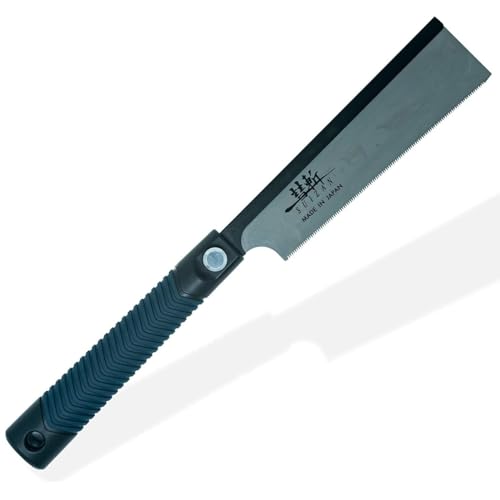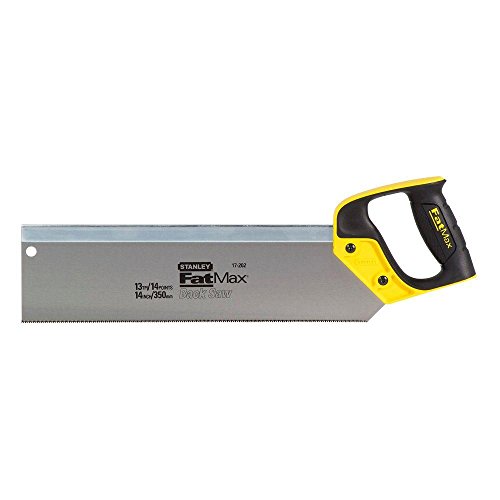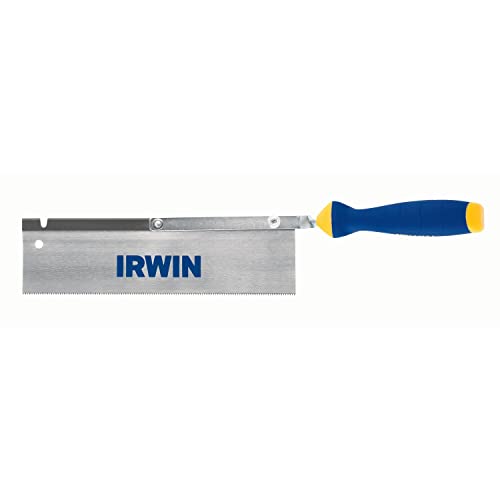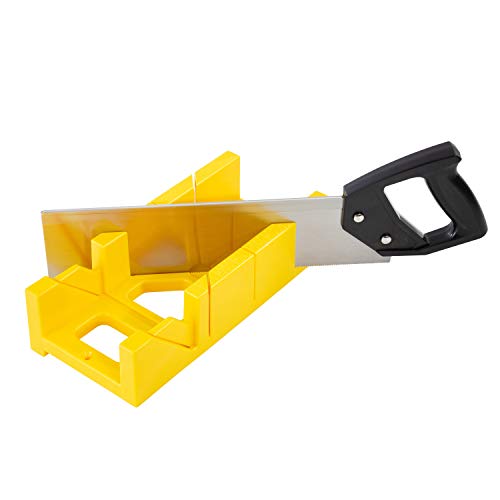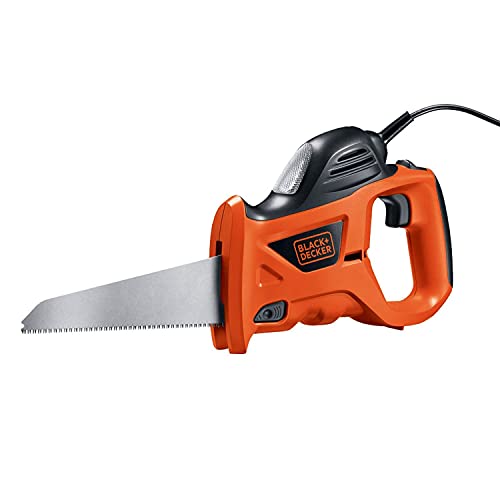The Best Hacksaws To Cut Through Any Material
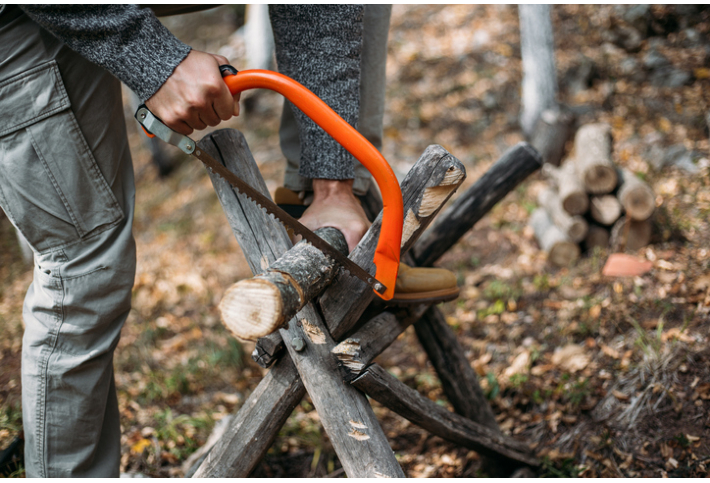
- Best Overall: Folding Hand Saw Wood Saw Shop Now ➔
- Runner Up: SUIZAN Japanese Pull Saw Hand Saw Shop Now ➔
- Honorable Mention: STANLEY FATMAX Hand Saw Shop Now ➔
- Also Consider: FLORA GUARD Folding Hand Saw Shop Now ➔
- Also Consider: Coher Folding Hand Saw Shop Now ➔
- Also Consider: Spear & Jackson 9550B Back Tenon Saw Shop Now ➔
- Also Consider: SUIZAN Japanese Dozuki Dovetail Hand Saw Shop Now ➔
- Also Consider: Stanley FatMax 17-202 14-Inch Back Saw Shop Now ➔
- Also Consider: IRWIN Dovetail Saw Shop Now ➔
- Also Consider: GreatNeck BSB14 12 Inch Mitre Box with 14 Inch Back Saw Shop Now ➔
- Also Consider: BLACK+DECKER Electric Hand Saw Shop Now ➔
Best Hacksaws of 2024
Best Overall
Pros
- Lightweight design, weighs only 10 ounces
- Comfortable rubber handle for superior grip
Cons
- Slotted screw requires infrequent tightening to prevent the blade from loosening
Key Features
This hand saw provides high precision with little force. It’s made from premium materials that are highly durable and don’t bend or break under high force or pressure. This hand saw is foldable and has a pull-cut saw design with a medium-tooth carbon steel blade that enables you to easily cut through wood, bone, and plastic measuring up to four inches in diameter. The hand saw has a strong gear lock that prevents it from snapping open inside the pocket or your backpack, making it very safe to carry.
Runner Up
Pros
- Has a long 9.5-inches blade so you can complete jobs quickly, also blade has both cross-cut and rip-cut teeth for more versatility
- Features an easy-gripping handle that is slip-resistant and effortless to use
Cons
- Handle is plastic-made with plastic lacing
Key Features
This saw has a unique Japanese double-edged design that makes it very useful for numerous cutting or sawing applications. This hand saw comprises premium quality Japanese steel that’s incredibly durable and sharp, thus making it easy for you to cut through various materials with ease. It’s lighter than comparable hand saws and can cut through wood with great precision and minimal effort.
Honorable Mention
Pros
- Exceptionally sharp blade, also long-lasting sharpness due to induction-hardened teeth
- Has a large and ergonomic rubber-coated handle for comfortable slip-resistant use
Cons
- Small blade size might not be suitable for cutting thick branches
Key Features
This hand saw is perfect for craftsmen or woodcutters who work with large blocks of wood. It has eight teeth per inch on its 15-inch blade that allow you to cut through wood 50% faster than comparable hand saws available online. The saw has a tough and durable stainless steel blade with induction-hardened teeth that are sharper than standard teeth. It also has a thick and ergonomic rubber-coated grip that makes it easy to hold and use, providing you with maximum comfort and stability as you cut through wood.
Also Consider
Pros
- Sharp triple-cut teeth design easily cuts through wood measuring up to four inches in diameter
- Has an eyelet that allows you to hang it on belt or bag for easy carry
Cons
- Can rust if exposed to water, not weather-resistant
Key Features
This heavy-duty hand saw has a compact and ergonomic design that makes it easy to hold and carry, with a triple-cut razor blade that’s strong enough to cut through large tree branches without bending or breaking. This saw is perfect for craftsmen and gardeners who have to work with large pieces of wood or tree branches. It has a heavy-duty ultra-sharp blade that provides a clean and precise cut and lets you work on jobs that require greater precision. It’s made from a strong high-grade stainless steel material that provides long-lasting durability and reliable performance.
Also Consider
Pros
- Has an anti-rust bolt that ensures a durable folding mechanism
- Slip-resistant handle for phenomenal grip and enhanced comfort during use
Cons
- Handle can break if too much pressure is applied to it
Key Features
This compact and heavy-duty hand saw provides great cutting power while requiring minimal effort. You can use it for a variety of purposes, such as pruning, gardening, hunting, woodcutting, and more. This product is made from highly durable steel and TPR materials that are perfect for long-term use with sufficient rust resistance.
Also Consider
Pros
- Extremely durable saw blade uses high-carbon steel and rivet-fixed handle
- Has a brass back that provides maximum rigidity
Cons
- Teeth are unhardened to allow resharpening
Key Features
This backhand saw is made for general uses like cutting across and along the grain, with its specialized ground teeth that offer universal cutting precision. You will find this saw to be very comfortable to use, with its conventional wooden handles that feel soft on the hands.
Also Consider
Pros
- Lightweight design that makes it very easy to use, weighs under 10 ounces
- Grooved handle for a comfortable and strong grip
Cons
- Thick upper panel can make some cuts a bit challenging to achieve
Key Features
The SUIZAN saw offers the durability and high quality that can be expected from Japanese craftsmanship, with steel that is incredibly sharp and creates excellent cuts. The 7-inch blade has an impressive 19 teeth per inch, allowing you to cut through thick branches with ease.
Also Consider
Pros
- Excellent blade size gets the job done faster and with less effort, measures 14-inches
- Safe to use, features heavy-duty screws to fix the handle to the blade
Cons
- Teeth are set for a cross-cut
Key Features
You can cut very precisely with this high-quality backhand saw, as it uses top-grade steel that makes its blade super sharp and extremely durable. The lifespan of this saw is further enhanced by the bi-material one-piece construction that also makes it very comfortable to use.
Also Consider
Pros
- Has an angled handle that allows easy trimming and cutting door jambs
- Lightweight portable construction that makes the saw very easy to use
Cons
- Curved handle might not allow this saw to function as a dovetail saw
Key Features
The ergonomic handle on this hand saw has a rubberized coating that provides exceptional grip while being soft enough to not cause any fatigue to your hands even with prolonged use. The saw has a spring-loaded mechanism so the blade can be switched between both left-hand and right-hand orientations with ease.
Also Consider
Pros
- Lightweight combination, both the saw and box weigh only two pounds
- Saw blade is made with highly durable steel material and has a serrated blade edge
Cons
- The miter box is made of plastic
Key Features
This 14-inch backhand saw comes with a 12-inch miter box that allows you to make precise cuts on any piece of wood. The box also has a ruler edge as well, making it easier for you to measure your cuts with greater accuracy.
Also Consider
Pros
- Blades can be easily changed without requiring any tools
- Has a long six-foot cord that provides excellent reach
Cons
- Comes with only two blade attachments
Key Features
The high-powered 3.4amp motor on this electric hand saw allows you to cut through some very thick pieces of wood with extreme precision and matchless ease. This saw has an ergonomic design with a compact form factor so it’s easy to operate and comfortable to use. The device also features a safety switch that ensures it remains idle until the button is pressed.
Best Hacksaws Buying Guide
Hand saws, like other staple tools, seem to be very simple and ordinary at first glance. But let’s face it, they are indispensable tools you cannot do without as a woodworker. Just like wood joints, the hand saw is a versatile cutting tool, with sharpened saw teeth and a solid handle, that is absolutely essential for making furniture and cutting wood/metal pieces into different shapes.
If you’re a woodworker, a landscaper, or work quite frequently with metal, then you need to check out the best hand saws available in the market. The following guide will provide you with all the information you need to make an informed decision.
What Factors Should I Consider Before Buying a Hand Saw?
Before hitting the market for a new hand saw, there are certain factors you must take into account. You definitely don’t want to spend money on a tool that doesn’t serve your needs.
Blade design
This is probably the most important feature to look out for when buying hand saws. The type of task you’re looking to perform will determine the kind of blade that’s suitable for you. So, when buying, ensure that your chosen hand saw has the desired tooth count, orientation, and shape of the blade. You should also check out the blade thickness of hand saws to be sure it’s ideal for your kind of work. Most comes with more than eight saw teeth per inch, a universal orientation allowing both left-hand and right-hand users to work with it, and a thin blade thickness that provides impeccable sharpness.
If you are thinking of cutting wood perpendicular to the wood grain, opt for a cross cut saw. The sawtooth patterns have four cutters. Cross cut saws also include saws with smaller hands that are used in carpentry. On the other hand, go for a rip saw if you looking forward to cutting wood with the grain. A rip saw is an all-purpose woodworking tool that specializes in making rough cuts. The rip saw teeth have cutting edges that are 90° to the blade.
Construction
What’s a good blade design without a solid build quality? While sifting through hand saws, make sure you prioritize durability over all other factors. No amount of reasonable force that’s exerted on the tool with daily use should be able to break it easily. It should be solid enough to withstand the pressure that comes with everyday use. Usually, hand saws that have a one-unit construction offer such strength and durability and provide long-lasting durability. If you are able to find an excellent blade but it has poor construction, it is likely to break very quickly and render the hand saw completely useless. Hence, durability is critical!
Grip
Using a hand saw can become exceptionally tough if it does not provide a good grip on the handle. While you want to ensure your saw is sharp enough to split up wood and metal with ease, you should also confirm its grip is good enough to improve efficiency. A poor saw grip poses a greater threat than just a decline in the quality of cuts. It can also result in chronic discomfort and cause the user to suffer from severe blisters. A handle that is not slip-resistant can also result in accidents.
Typically, a good hand saw handle should have a rubberized grip that is soft and slip-resistant, providing a firm grip to your hands that feels comfortable even after prolonged sessions of cutting wood.
Size
Consideration for size is not usually a strict one, and here’s what that means: whether you are going for a big hand saw or you’re buying a much smaller one, what matters is you’re buying one that suits your task and your work environment. The size of your hand saw does not exactly determine its quality. A saw with a smaller hand can work just as effectively as a bigger one, provided it is used for the right task. Of course, you cannot expect a small hand saw for cutting wood.
Interchangeable blades
Though this relates more to particular types of hand saws, it is yet essential to discuss. On some designs, the saw blades are usually interchangeable and can be replaced to suit specific cutting jobs. But, before opting for a saw that provides interchangeable blades, make sure you need this feature as it can be an added cost that you may be able to avoid by choosing a simpler hand saw.
Unlike a coping saw that cuts on the pull stroke, the hacksaw has teeth that are pointed away from the handle. The coping saw blade is removable by partially unscrewing the handle. Though not as efficient as a hacksaw, the blades of the coping saw can also cut through aluminum tubing and other metal objects.
Folding blade
Here’s the feature that makes hand saws very easy to carry and store. If you’re a remote worker or one that hauls equipment from one site to another, you may want to look for a foldable hand saw. These hand saws are much safer to carry as the blade completely hides inside the rubberized handle. Opt for more saw teeth blades if you are looking for a smoother cut, while blades with fewer saw teeth remove material faster.
Check the video from This Old House where woodworking expert Tom Silva talks about various types of hand saws and their best uses.

People Also Asked
What can I use a hand saw for?
Essentially, you can use a hand saw for cutting wood/metal/plastic into different shapes. But your saw’s particular design and blade type go a long way in determining the type and thickness of material it can handle.
Can I cut metal with my hand saw?
Well, that depends largely on the type of hand saw you’re using. A hack saw, for instance, may be good for cutting metal since its blade is well-suited to that purpose, but a backsaw isn’t.
Can a hand saw cut wood?
Yes, it can. Most handsaws on the market are intended specifically for cutting wood, though there are some meant solely for plastic or metal cutting.
How can I choose the best hand saw?
To choose the best hand saw, it is important you consider the design and blade type. You should take into consideration the task you’re looking to perform to choose the most suitable hand saw. Guides like this help you make a better choice of hand saw for your needs.
Can I sharpen my hand saw?
You sure can. To sharpen your hand saw, you’d need a tapered file. But ensure to look out for uneven saw teeth when sharpening.
Article Contributors
The Woodsmith Review Team’s product reviews and in-depth guides are here to help you choose the best tools and gear to build great-looking projects confidently. Woodsmith is reader-supported: When you buy through links on our site, we may earn an affiliate commission. Large language models (like Artificial Intelligence) may have been used in the research and creation of the content.
Inquiries regarding specific articles or product testing should be sent to aimperiapt@gmail.com

